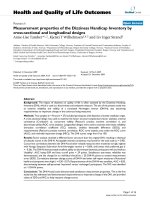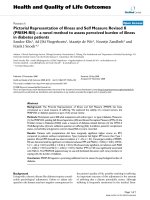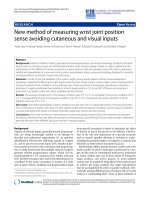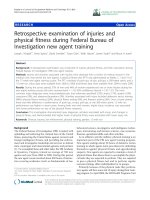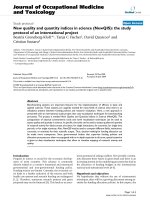báo cáo hóa học: "New method of measuring wrist joint position sense avoiding cutaneous and visual inputs" docx
Bạn đang xem bản rút gọn của tài liệu. Xem và tải ngay bản đầy đủ của tài liệu tại đây (817.68 KB, 7 trang )
JNER
JOURNAL OF NEUROENGINEERING
AND REHABILITATION
Gay et al. Journal of NeuroEngineering and Rehabilitation 2010, 7:5
/>Open Access
RESEARCH
© 2010 Gay et al; licensee BioMed Central Ltd. This is an Open Access article distributed under the terms of the Creative Commons At-
tribution License ( which permits unrestricted use, distribution, and reproduction in any
medium, provided the original work is properly cited.
Research
New method of measuring wrist joint position
sense avoiding cutaneous and visual inputs
Andre Gay, Kimberly Harbst, Kenton R Kaufman, Diana K Hansen, Edward R Laskowski and Richard A Berger*
Abstract
Background: Aspects of afferent inputs, generally termed proprioception, are being increasingly studied. Extraneous
factors such as cutaneous inputs can dramatically interfere while trying to design studies in order to determine the
participation of the different structures involved in proprioception in the wrist position sense. We tried to determine
validity and repeatability of a new wrist joint position measurement device using methodology designed to minimize
extraneous factors and isolate muscle and joint inputs.
Methods: In order to test the reliability of the system, eighty young-adult subjects without musculoskeletal or
neurologic impairments affecting the right upper extremity were tested using a custom made motion tracking system.
Testing consisted of two conditions: active reproduction of active placement and passive reproduction of passive
placement. Subjects performed two repetitions of each target position (10, 20, and 30° of flexion and extension)
presented in a random order. Test- retest reliability was then tested.
Results: The average constant error in the passive condition was -0.7° ± 4.7° as compared to the active condition at 3.7°
± 5.1°. Average absolute error in the passive condition was 4.9° ± 2.9° compared to the active condition in which
absolute error was 5.9° ± 3.5°.
Discussion: Test-retest repeatability in both conditions was less than the 5° magnitude typical of clinical goniometry.
Errors in the active condition (less than 2°) were slightly smaller than the passive condition, and the passive condition
was also associated with poorer consistency between apparatus sensors and skin sensors.
Conclusions: The current system for measurement of wrist joint proprioception allows the researcher to decrease
extraneous influences that may affect joint position sense awareness, and will help in future study aiming to determine
precisely the role of the different structure involved in proprioception.
Background
Aspects of afferent inputs, generally termed propriocep-
tion, are being increasingly studied in an attempt to
describe and understand impairments [1], to optimize
rehabilitation effectiveness following trauma or surgery
[1], and to prevent recurrent injury [2-9]. Results of pre-
vious studies have led to the conclusion that propriocep-
tion is multi-faceted and that multiple sensory receptors
generate afferent proprioceptive inputs: Visual [10-14],
muscle spindle [15-17], cutaneous [18], tendon and joint
[19]. All these receptors have each been demonstrated to
contribute to the sense of position or motion of a body
part in space [20,21]. Isolating each proprioceptive input
from specific structures in order to determine the effect
of disease or injury has proven to be difficult. Clarifica-
tion of the role and importance of a specific structure
such as muscle spindles afferents is essential to under-
standing the potential impact of surgeries or injuries that
diminish or destroy those structures [8,22,23].
Methodology differs greatly between studies and even
within studies in which a body part is positioned as a tar-
get and the same or contralateral body part is positioned
to match. Studies also vary in their means of setting the
target position, and active, passive, or active-assisted
motion may be employed. Regardless of the method used
to achieve the target position, the target reproduction
may be accomplished by active or passive methods. The-
oretically, pairing different types of motions [24-27] could
result in a confounding effect. None of these methods of
* Correspondence:
1
Biomechanics Laboratory, Division of Orthopedic Research, Mayo Clinic, 200
First Street SW. Rochester, MN 55095, USA
Gay et al. Journal of NeuroEngineering and Rehabilitation 2010, 7:5
/>Page 2 of 7
assessing target position reproduction has been adopted
as a standard, which likely contributes to variability of
results.
Reliability measures for proprioception testing have
been in the .85 95 range at more proximal joints [27-31].
Redundant sensory information may, however, allow the
subject to produce more reliable results than may be
afforded if extraneous factors are minimized. Techniques
utilized to measure joint angles or limb position also
present potential confounding factors.
In previous studies, researchers have objectively docu-
mented joint position sense using dynamometers [32,33]
electrogoniometers, potentiometers [34], electromag-
netic sensors [6,21,35], and video digitization/analysis
[36]. Reproducibility of wrist motion measurement using
a simple goniometer was reported as 5-8° (intra-observer)
and 6-10° (inter-observer) [37]. At the elbow joint, reli-
ability using the electrogoniometer was shown to be
superior to either a universal goniometer or a fluid goni-
ometer [38]. The repeatability of electromagnetic sensors
is anticipated to be superior to standard goniometric
measurements, but has not been demonstrated for the
wrist.
The purpose of this study is to formulate a valid and
repeatable method for testing wrist joint position sense
avoiding stimulating cutaneous inputs. Optimal method-
ology entails isolating muscle spindles and/or joint recep-
tors contribution to proprioception at the wrist while
minimizing extraneous influences using a non-invasive
method.
Methods
Subjects participating in this study included eighty,
healthy, 20-65 year-old volunteers. This study was
approved by our Institutional Review Board. Informed
consent to participate was obtained. Each subject was
seated in a custom-made chair with both forearms sup-
ported on armrests attached to a plexiglass desktop (Fig-
ure 1). The forearm supports were lined with 3 cm thick,
slow-recovery, viscoelastic foam. The subject's right arm
was positioned in neutral forearm pronation/supination
and neutral wrist flexion/extension. Thus, wrist motion
occurred in a plane parallel to the desktop. Two electro-
magnetic sensors (Flock of Birds; Ascension Technology,
Burlington, VT) were attached to the dorsal forearm and
the middle of the dorsal aspect of the third metacarpal to
measure wrist flexion/extension. An additional 1.5-inch
thick piece of foam was placed over the length of the right
forearm and two straps encircled the forearm and foam
to secure the forearm to the armrest (Figure 2) and isolate
wrist motion while decreasing extraneous cutaneous
input. Finger lengths of tubular dressings (Xspan
®
) with
hook surfaced Velcro
®
strips attached were applied to the
right thumb, index, and middle fingers. The subject was
Subject seated in experimental apparatus
Figure 1 Subject seated in experimental apparatus. Components
of the apparatus are labeled: A) Forearm support, B) Slow-recovery
foam, C) Plexiglass desktop, D) Skin Sensors, E) Manipulandum, F) Ma-
nipulandum Sensors, G) Finger tubular dressings, H) Manipulandum
projection, I) Air jets.
Close up of experimental apparatus with foam forearm sta-
bilization and straps in place
Figure 2 Close up of experimental apparatus with foam forearm
stabilization and straps in place.
Gay et al. Journal of NeuroEngineering and Rehabilitation 2010, 7:5
/>Page 3 of 7
asked to gently grip a vertical upright cylindrical experi-
mental apparatus (manipulandum) covered in loop-sur-
faced Velcro
®
with a 3/4-inch dowel rod interposed within
the first web space to minimize wrist extension with fin-
ger flexion due to tenodesis. The subject was instructed
to relax and the wrist joint position was measured with a
plastic goniometer to assure neutral flexion/extension
alignment.
The base of the manipulandum was a Plexiglas disc
encasing air jets that, when engaged, allowed frictionless
wrist flexion/extension motion over the Plexiglas desk-
top. A single electromagnetic sensor was attached to the
lateral upright of the manipulandum to measure wrist
flexion/extension. The wrist joint and sensor alignments
were adjusted so that the goniometric and sensor read-
ings all indicated a neutral alignment. All electromag-
netic sensors measured position with respect to a source
that was mounted anterior and left of the subject on the
Plexiglas desktop.
When used for wrist joint position testing, the experi-
mental apparatus was designed to use the sensor located
on the manipulandum as an indicator of wrist angle or
motion.
Testing Sequence
Subjects were tested in an "active" and a "passive" condi-
tion. Repeatability was calculated by comparing joint
excursion measures during two different sessions. Testing
positions included two repetitions each of ten, twenty,
and thirty degrees of flexion and extension presented in a
random order. In the active and passive conditions, the
starting position for flexion target angles was wrist exten-
sion; and for extension target angles, the starting position
was wrist flexion. For all target angles, actual location of
the starting position was varied between the positioning
and repositioning components of the trial to avoid sub-
jects reproducing the extent of motion rather than joint
position. Regardless of the starting position, a minimum
excursion of 20° was used for all trials. All the subjects
had a training session before starting the experiment in
order to minimize the learning effect of the test-retest
comparison.
The passive condition began when the examiner gently
oscillated the subject's wrist between flexion and exten-
sion to assure relaxation. The wrist was moved to a target
position and maintained for three seconds while the sub-
ject was instructed to remember the position. The wrist
was once again oscillated to assure relaxation, passively
placed in a different starting position, and then slowly
moved toward the target position. The subject was
instructed to verbally cue the examiner to stop when the
wrist had reached the target position. The target position
was then changed and the sequence was repeated. Wrist
position was recorded at each stop.
The active condition began by placing the subject's
right wrist in a starting position on the opposite side of
neutral compared to the target position. The subject was
asked to move the hand either "slowly toward your stom-
ach" or "slowly away from your stomach". The subject's
motion was stopped when the examiner physically
restrained the manipulandum upon reaching the target
position and held for three seconds while instructing the
subject to remember the position. The subject was
instructed not to push against the restraint. The subject
was asked to relax and was passively moved to a different
starting position. The subject actively returned to the tar-
get position at their desired rate of speed, indicating to
the examiner when the target position was reached.
Sensor Placement
In order to determine the best possible placement for the
sensors, joint flexion/extension excursion calculated
from measures taken with a manipulandum placed sen-
sor were compared to measures from skin mounted sen-
sors in a pilot study on five patients. A Bland-Altman
Graph (a plot of the difference between reproduced angle
and the mean reproduced angle) was created for both
active and passive conditions to compare visually the skin
and manipulandum placement (Figures 3 and 4). The
purpose of Bland-Altman plots is to allow visual inspec-
tion of the data to investigate biases and to examine
potential relationships between the disagreement and the
true value. Then, an Intraclass Correlation Coefficient
(ICC) type 2,1 with 95% confidence intervals of the test-
retest repeatability between trial and between marker
placement during active and passive motion and for the
Bland-Altman graph of manipulandum mounted sensor
Figure 3 Bland-Altman graph of manipulandum mounted sen-
sor. The dashed line represents the mean difference (1°) between the
skin and manipulandum placement of the sensor in active condition.
The dotted lines represent 2 standard deviations (SD) (+3 and -1°).
Gay et al. Journal of NeuroEngineering and Rehabilitation 2010, 7:5
/>Page 4 of 7
joint excursion measures is taken from each sensor place-
ment during two different sessions. Measurements were
captured at 30° increments through a 60° arc of motion (±
30° flexion/extension). Repeatability coefficients [39]
were calculated to determine the disparity of distance
moved between pairs of measures between marker sets.
Arc of motion by sensors on the apparatus demonstrated
greater inter-trial repeatability than did skin mounted
sensors in both active and passive condition (Figure 5).
We then decided to use the manipulandum mounted sen-
sor for the rest of the experiment.
Data Collection and Statistical Analysis
First, sample descriptive statistics (means and standard
deviation) were calculated for each testing. Signed differ-
ence between the targeted position and the repositioned
angle (constant error) and the absolute value of that dif-
ference (absolute error) were calculated. The standard
deviation of the constant error, also known as variable
error, was analyzed as an indicator of the consistency of
the error. An ANOVA with repeated measure was then
used to compare the results in active and passive condi-
tions.
Results
The average constant error in the passive condition was -
0.7° ± 4.7° as compared to the active condition at 3.7° ±
5.1°. Average absolute error in the passive condition was
4.9° ± 2.9° compared to the active condition in which
absolute error was 5.9° ± 3.5°. An ANOVA with repeated
measures revealed significant differences between the
passive and active conditions in constant (p < 0.0001) and
absolute (p = 0.0084) error. Variable error in the active
and passive conditions were not significantly different
(passive = 4.2°; active = 4.6°; p = 0.1720). These results are
summarized in Table 1.
Bland-Altman graph of skin mounted sensor
Figure 4 Bland-Altman graph of skin mounted sensor. The dashed
line represents the mean difference (-2°) between the skin and manip-
ulandum placement of the sensor in active condition. The dotted lines
represent 2 standard deviations (SD) (+2 and -6°).
Repeatability of range of motion measurements between
sessions taking into account type of activity and sensor
placements
Figure 5 Repeatability of range of motion measurements be-
tween sessions taking into account type of activity and sensor
placements. Repeatability coefficient is better, both in active and pas-
sive condition, when the sensors are placed on the manipulandum
rather than directly on the skin.
Table 1: Descriptive statistics of the constant, absolute and variable error for active and passive conditions.
Active Passive P value
Constant 3.7° ± 5.1° -0.7° ± 4.7° < 0.001
Absolute 5.9° ± 3.5° -4.9° ± 2.9° 0.0084
Variable 4.6° 4.2° 0.172
Gay et al. Journal of NeuroEngineering and Rehabilitation 2010, 7:5
/>Page 5 of 7
Discussion
Minimizing external influences on proprioceptive input
in order to determine the effect of disease or injury has
proven to be difficult. These methodological variances
make it difficult to reliably isolate and quantify input
from a specific structure. Clarification of the role and
importance of a specific structure such as muscle spin-
dles afferents is essential to understanding the potential
impact of surgeries or injuries that diminish or destroy
those structures [8,22,23].
Skin-mounted markers or electrogoniometers have
been used previously in research and clinical assessment
of range of motion [6,21,32-36]. These methods were
deemed inappropriate for studies attempting to isolate
joint contributions to proprioceptive sense because the
resultant pressure and cutaneous stretch contribute
redundant sensory information about limb position. Our
experimental configuration minimized gravitational
influences, cutaneous sensory input, and friction to
emphasize, if not isolate, muscle spindles contribution to
position sense in active versus passive motions. In the
current experiment, subjects were not asked to precisely
reproduce any joint angles. The data from this study will
serve as a baseline measure of experimental setup reli-
ability allowing future studies to differentiate subject
variability over and above this demonstrated experimen-
tal variability, and to isolate joint or muscle propriocep-
tive inputs from each other. The technology utilized in
this study (3-dimensional Flock of Birds motion tracking
system) has a reported accuracy of .5° - 2° [29,30,40].
Remaining variability will be attributed to the experimen-
tal apparatus and stabilization methodology.
Errors associated with the active condition were similar
to the findings of previous studies, which reported errors
of 5° or less [25,27]. Values were superior to range of
motion measurements obtained using an instrumented
glove designed to capture hand and wrist motions which
resulted in repeatability of 6.17° [41]and to goniometry
which has been found to be associated with 5-8° intra-
and 6-10° inter-rater reliability at the wrist [37].
Marker placement on the manipulandum appeared to
result in more repeatable measures of arcs of motion than
did sensors placed directly on the skin. Skin markers may
have yielded variable measures because of altered sensor
alignment when soft tissues were deformed during
motion. For example, during wrist extension, the forearm
likely pressed against the lateral support causing the skin
to indent and sensor alignment to change. Also, sensor
placement on the dorsal forearm could have resulted in
slight sensor motion as a result of the motion or stretch
on the wrist muscle tendons running under the sensor.
While it was the intent to establish concurrent validity
with a tool known to provide accurate measures of
motion, we propose that skin electrode placement was
not the appropriate tool. It is our contention that since
the use of joint repositioning to test proprioception
involves comparing the difference between the angle at
which the body part is placed and the angle at which it is
repositioned, reliable measures are as important as pre-
cise measurement of an exact angle. Regardless of sensor
placement, the passive condition was consistently associ-
ated with less precise repeatability. This methodological
variability between active and passive measures forms a
baseline of inaccuracy when passive limb placement is
paired with active repositioning. This does not take into
account the errors anticipated due to different sensory
input contributing to joint position sense in active versus
passive motion [21].
One explanation for the methodological differences in
reproducibility associated with active and passive
motions is that slight extraneous motion may have
occurred at the metacarpophalangeal and interphalan-
geal joints during passive movement of the wrist joint via
the manipulandum. In addition, the tubular dressing
placed on the fingers could have stretched slightly, allow-
ing a small amount of manipulandum rotation within the
palm during passive motion. Another explanation is that
the active motion, by stimulating the gamma loop, allows
a more precise message encoding by the antagonist mus-
cle spindles Ia fibers [17,42,43].
The difference in repeatability between the active and
passive conditions lends support for pairing active posi-
tioning with active repositioning and passive positioning
with passive repositioning when testing joint position
sense. Repeatability errors of 1° in the active condition
and 3° in the passive condition using manipulandum
mounted markers are within acceptable ranges to allow
assessment of clinically significant differences of joint
position sense.
Conclusions
The importance of proprioception in rehabilitation fol-
lowing musculoskeletal trauma and surgery is becoming
increasingly evident, which has lead to a correspondingly
increased need to understand the underlying neural
mechanisms related to joint mechanics. The system uti-
lized in the current study appears to produce an accurate
and repeatable measure of active and passive motion. Dif-
ferences in variability in active and passive conditions are
slight with the current methodology. However, poorer
reliability in passive measurements in the skin-mounted
sensors lends support for the concept that active and pas-
sive motions yield different results. The primary advan-
tage of the current system for measurement of wrist joint
proprioception is that it allows the researcher to decrease
extraneous influences that may affect joint position sense
awareness and therefore improve the knowledge of the
mechanisms underlying kinesthesia and proprioception.
Gay et al. Journal of NeuroEngineering and Rehabilitation 2010, 7:5
/>Page 6 of 7
The results of this study indicate that the measures are
repeatable and appear to be equally or more accurate
than other measures previously employed to measure
wrist and hand range of motion. Nevertheless, other
study in order to verify the external validity of this
method will be needed.
Competing interests
The authors declare that they have no competing interests.
Authors' contributions
AG carried out the data analysis and drafted the manuscript, KH carried out the
data collection and performed the statistical analysis, KRK conceived, designed
and coordinated the study, and helped with the manuscript redaction, DKH
helped in the data collection and reduced the data, ERL and RAB conceived
the study and participated in its design and coordination. All the authors read
and approved the final manuscript.
Acknowledgements
The authors would like to thanks Kari Hammel for her help in the submission
process of the present manuscript.
This study was supported by NIH grant R01 AR047806-02.
Human Kinetics, 1607 N Market St, Champaign, IL 61825.
Author Details
Biomechanics Laboratory, Division of Orthopedic Research, Mayo Clinic, 200
First Street SW. Rochester, MN 55095, USA
References
1. Gay A, Parratte S, Salazard B, Guinard D, Pham T, Legre R, Roll JP:
Proprioceptive feedback enhancement induced by vibratory
stimulation in complex regional pain syndrome type I: An open
comparative pilot study in 11 patients. Joint Bone Spine 2007.
2. Khudados E, Cody F, O'Boyle D: Proprioceptive regulation of voluntary
ankle movements, demonstrated using muscle vibration, is impaired
by Parkinson's disease. Journal of Neurology, Neurosurgery, & Psychiatry
1999, 67:504-510.
3. Rome S, Grünewald R: Abnormal perception of vibration-induced
illusion of movement in dystonia. Neurology 1999, 53:1794-1800.
4. Konradsen L, Magnusson P: Increased inversion angle replication error
in functional ankle instability. Knee Surg Sports Traumatol Arthrosc 2000,
8:246-251.
5. Miall R, Ingram H, Cole J, Gauthier G: Weight estimation in a
"deafferented" man and in control subjects: Are judgments influenced
by peripheral or central signals. Exp Brain Res 2000, 133:491-500.
6. Newcomer K, Laskowski E, Yu B, Johnson J, An K-N: Differences in
repositioning error among patients with low back pain compared with
control subjects. Spine 2000, 25:2488-2493.
7. Ng G, Chan H: The immediate effects of tension of counterforce
forearm brace on neuromuscular performance of wrist extensor
muscles in subjects with lateral humeral epicondylitis. Journal of
Orthopaedic & Sports Physical Therapy 2004, 34:72-78.
8. Myers J, Lephart S: Sensorimotor deficits contributing to glenohumreal
instability. Clinical Orthopaedics and Related Research 2002, 400:98-104.
9. Willems T, Witvrouw E, Verstuyft J, Vaes P, De Clercq D: Proprioception
and muscle strength in subjects with a history of ankle sprains and
chronic instability. Journal of Athletic Training 2002, 37:487-493.
10. Plooy A, Tresilian J, Mon-Williams M, Wann J: The contribution of vision
and proprioception to judgements of finger proximity. Exp Brain Res
1998, 118:415-420.
11. Graziano M: Where is my arm? The relative role of vision and
proprioception in the neuronal representation of limb position. Proc
Natl Acad Sci USA 1999, 96:10418-10421.
12. van Beers R, Sittig A, Gon J Denier van der: Localization of a seen finger is
based exclusively on proprioceptoin and on vision of the finger. Exp
Brain Res 1999, 125:43-49.
13. Brindle T, Uhl T, Nitz A, Shapiro R: Motor control of shoulder
proprioception at various speeds. Physical Therapy 2003, 33:109-117.
14. Sober S, Sabes P: Multisensory integration during motor planning. The
Journal of Neuroscience 2003, 23:6982-6992.
15. Gandevia S, McCloskey D: Joint sense, muscle sense, and their
combination as position sense measured at the distal interphalangeal
joint of the middle finger. J Phys 1976, 260:387-407.
16. Gandevia S, McCloskey D, Burke D: Kinaesthetic signals and muscle
contraction. Trends Neurosci 1992, 15:62-65.
17. Roll JP, Vedel JP: Kinaesthetic role of muscle afferents in man, studied
by tendon vibration and microneurography. Exp Brain Res 1982,
47:177-190.
18. Voight ML, Hardin JA, Blackburn TA, Tippett S, Canner GC: The effects of
muscle fatigue on and the relationship of arm dominance to shoulder
proprioception. J Orthop Sports Phys Ther 1996, 23:348-352.
19. Gandevia SC, Burke D: Does the nervous system depend on kinesthetic
information to control natural limb movements? Behav Brain Sci 1992,
15:614-632.
20. Verschueren S, Cordo P, Swinnen S: Representation of wrist joint
kinematics by the ensemble of muscle spindles from synergistic
muscles. J Neurophysiol 1998, 79:2265-2276.
21. Lönn J, Crenshaw AG, Djupsjöbacka M, Pedersen J, Johansson H: Position
sense testing: Influence of starting position and type of displacement.
Arch Phys Med Rehabil 2000, 81:592-597.
22. Hogervorst T, Brand R: Mechanoreceptors in joint function. J Bone Joint
Surg Am 1998, 80-A:1365-1378.
23. Ishii Y, Tojo T, Terajima K, Terashima S, Bechtold JE: Intracapsular
components do not change hip proprioception. J Bone Joint Surg Br
1999, 81-B:345-348.
24. Voigt M, Jakobsen J, Sinkjaer T: Non-noxious stimulation of the
glenohumeral joint capsule elicits strong inhibition of active shoulder
muscles in conscious human subjects. Neuroscience Letters 1998,
2:105-108.
25. Stillman B, McMeeken J, Macdonnell R: After effects of resisted muscle
contractoins on the accuracy of joint positoin sense in elite male
athletes. Arch Phys Med Rehabil 1998, 79:1250-1254.
26. Ramsay J, Riddoch M: Position-matching in hte upper limb: Professional
ballet dancers perform with outstanding accuracy. Clinical
Rehabilitation 2001, 15:324-330.
27. Dover G, Powers ME: Reliability of joint position sense and force-
reproduction measures during internal and external rotation of the
shoulder. Journal of Athletic Training 2003, 38:304-310.
28. Petrella R, Lattanzio P, Nelson M: Effect of age and activity on knee joint
proprioception. American Journal of Physical Medicine & Rehabilitation
1997, 76:235-241.
29. Meskers C, Fraterman H, Helm F van der, Vermeulen H, Rozing P:
Calibration of the "Flock of Birds" electromagnetic tracking device and
its application in shoulder motion studies. Journal of Biomechanics
1999, 32:629-633.
30. Ying N, Kim W: Use of dual Euler angles to quantify the three-
dimensional joint motion and its application to the ankle joint
complex. Journal of Biomechanics 2002, 35:1647-1657.
31. Deshpande N, Connelly D, Culham E, Costigan P: Reliability and validity
of ankle proprioceptive measures. Arch Phys Med Rehabil 2003,
84:883-889.
32. Iwasa J, Ochi M, Adachi N, Tobita M, Katsube K, Uchio Y: Proprioceptive
improvement in knees with anterior cruciate ligament reconstruction.
Clinical Orthopaedics and Related Research 2000, 381:168-176.
33. Janwantanakul P, Magarey M, Jones M, Dansie B: Variation in shoulder
position sense at mid and extreme range of motion. Arch Phys Med
Rehabil 2001, 82:840-844.
34. Cash R, Gonzalez M, Garst J, Barmada R, Stern S: Proprioception after
arthroplasty: role of the posterior cruciate. ligament. Clinical
Orthopaedics and Related Research 1996, 331:172-178.
35. Newcomer K, Laskowski E, Yu B, Johnson J, An K-N: The effects of a
lumbar support on repositioning error in subjects with low back pain.
Arch Phys Med Rehabil 2001, 82:906-910.
36. Baker V, Bennell K, Stillman B, Cowan S, Crossley K: Abnormal knee joint
position sense in individuals with patellofemoral pain syndrome.
Journal of Orthopedic Research 2001, 20:208-214.
37. Solgaard S, Carlsen A, Kramhoft M, Petersen VS: Reproducibility of
goniometry of the wrist. Scand J Rehabil Med 1986, 18:5-7.
Received: 6 May 2009 Accepted: 10 February 2010
Published: 10 February 2010
This article is available from: 2010 Gay et al; licensee BioMed Central Ltd. This is an Open Access article distributed under the terms of the Creative Commons Attri bution License ( /2.0), which permits unrestricted use, distribution, and reproduction in any medium, provided the original work isproperly cited.Journal of NeuroEngineering and Rehabilitation 2010, 7:5
Gay et al. Journal of NeuroEngineering and Rehabilitation 2010, 7:5
/>Page 7 of 7
38. Goodwin J, Clark C, Deakes J, Burdon D, Lawrence C: Clinical methods of
goniometry: a comparative study. Disabil Rehabil 1992, 14:10-15.
39. Bland J, Altman D: Statistical methods for assessing agreement
between two methods of clinical measurement. Lancet 1986:307-310.
40. Bull AM, Amis AA: Accuracy of an electromagnetic tracking device.
Journal of Biomechanics 1997, 30:857-859.
41. Dipietro L, Sabatini A, Dario P: Evaluation of an instrumented glove for
hand-movement acquisition. Journal of Rehabilitation Research and
Development 2003, 40:179-190.
42. Ribot-Ciscar E, Bergenheim M, Albert F, Roll J-P: Proprioceptive
population coding of limb position in humans. Exp Brain Res 2003,
149:512-519.
43. Roll JP, Vedel JP, Roll R: Eye, head and skeletal muscle spindle feedback
in the elaboration of body references. Prog Brain Res 1989, 80:113-123.
doi: 10.1186/1743-0003-7-5
Cite this article as: Gay et al., New method of measuring wrist joint position
sense avoiding cutaneous and visual inputs Journal of NeuroEngineering and
Rehabilitation 2010, 7:5

